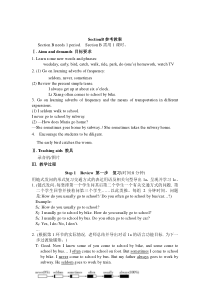 DOC
DOC
【文档说明】Unit 5 Topic 1《I usually come to school by subway》(SectionB)word教案-七年级下册英语【仁爱版】.doc,共(4)页,42.000 KB,由小喜鸽上传
转载请保留链接:https://www.ichengzhen.cn/view-104094.html
以下为本文档部分文字说明:
SectionB参考教案SectionBneeds1period.SectionB需用1课时。Ⅰ.Aimsanddemands目标要求1.Learnsomenewwordsandphrases:weekday,early,bird,catch
,walk,ride,park,do(one’s)homework,watchTV2.(1)Goonlearningadverbsoffrequency:seldom,never,sometimes(2)Reviewthepresentsimpletense.Ialways
getupataboutsixo’clock.LiXiangoftencomestoschoolbybike.3.Goonlearningadverbsoffrequencyandthemeansoftransportationindifferente
xpressions.(1)Iseldomwalktoschool.Inevergotoschoolbysubway.(2)—HowdoesMariagohome?—Shesometimesgoeshom
ebysubway./Shesometimestakesthesubwayhome.4.Encouragethestudentstobediligent.Theearlybirdcatchestheworm.Ⅱ.Teachingaids教具录音机/图片Ⅲ.
教学过程Step1Review第一步复习(时间:8分钟)用链式发问的形式复习交通方式的表达用语及相关句型导出1a,呈现并学习1c。1.(链式发问。每竖排第一个学生问其后第二个学生一个有关交通方式的问题,第二个学生回答并接着问第三个学生……以此类推。每组2分
钟时间。问题是:Howdoyouusuallygotoschool?/Doyouoftengotoschoolbybus/car…?)Example:S1:Howdoyouusuallygotoschool?S2:Iusuallygotoschool
bybike.Howdoyouusuallygotoschool?S3:Iusuallygotoschoolbybus.Doyouoftengotoschoolbycar?S4:Yes,Ido./No,Idon’t.…2.(根据第1环节的实际情况,老师
总结并导出对话1a的语言功能目标,为下一步过渡做铺垫。)T:Good.NowIknowsomeofyoucometoschoolbybike,andsomecometoschoolbybus…Ioftencometoschoolon
foot.ButsometimesIcometoschoolbybike.Inevercometoschoolbybus.Butmyfatheralwaysgoestoworkbysubway.Heseldomgoestoworkbytrain.3.(板书并讲解以下频度副词。)
Step2Presentation第二步呈现(时间:5分钟)呈现1a。1.(通过了解学生的起床时间,引出谚语Theearlybirdcatchestheworm。让学生猜测这句谚语的意思。)T:OK,boysandgirls,whattimedoyou
usuallygetup?S1:Iusuallygetupathalfpastsix.S2:…T:Yes,weshouldgotobedearlyandgetupearly.Asthesayinggoes,“Theearlybirdcatchestheworm.”Whokn
owsthemeaningofthissentence?(让学生猜测,教师板书并加以讲解,并教导学生们在学习和生活中都应该勤奋、努力。)Theearlybirdcatchestheworm.2.(根据1a的主要信息,设置听力任务,让学生带着
任务听1a的录音,可以提高兴趣、降低难度。)T:Listento1aandfindouttheanswerstothesequestionsontheblackboard.(板书问题及生词。)weekday,early,bird,catch,walk
,seldom,never(1)WhattimedoesMichaelgetuponweekdays?(2)HowdoesMichaelusuallygotoschool?(3)DoesSallyoftengotoschool
bysubway?(4)Whoalwaystakesabustoschool?3.(让学生再听一遍1a的录音并核对答案。)(Keystothequestions)(1)Hegetsupataboutsixo’clock.(2)Heusuallygoestoschoolonfoot.(3)No,sh
edoesn’t.(4)Sallyalwaystakesabustoschool.Step3Consolidation第三步巩固(时间:5分钟)巩固1a和1b的内容。1.(放1a的录音,让学生跟读并模仿语音和语调)T:Followthetapeandpayattentiontoyo
urpronunciationandintonation.Ready?Go!2.完成1b的内容,然后核对答案2.(人机对话,提高学生的兴趣。)T:OK.SupposeyouareMichaelandS
ally.ListentothetapeandmakeadialogwithHelen.3.(让学生分角色表演1a,小组之间进行比赛)T:Good!Nowlet’sworkingroupsandactout1a.Thenwe’llchoosethebestone
.Step4Practice第四步练习(时间:15分钟)呈现2a的图片,呈现同义替换,完成2b和3。1.(1)(呈现2a的图片,通过师生互动,让学生进一步了解和巩固语言知识。)T:Lookatthesecondpicture.HowdoesMariagohome?Ss:Sh
egoeshomebysubway.T:Yes,wecanalsosay:shetakesthesubwayhome.(同样的,通过谈论第1、3、4幅图,可以得到以下几个句子。)LiXiangcomestoschoolbybike./LiXiangrid
esabiketoschool.Wegototheparkonfoot./Wewalktothepark.Theygotothezoobybus./Theytakeabustothezoo.(呈现同义替换,加强对交通工具表达方式的灵活运用。总结并板书。)bysubway—
takethesubwaybybike—rideabikeonfoot—walkbybus—takeabusbycar—takeacarbyplane—fly(2)(引导学生归纳总结1a和2a中频度副词的用法,并进行操练。)T:Findoutthesentenceswitht
headverbsoffrequency,payattentiontotheirusageandthenmakesentences.2.(让学生完成2b。)T:Now,talkaboutthepicturesin2awit
hyourpartner.Example:S1:HowdoesMariagohome?S2:Shesometimesgoeshomebysubway./Shesometimestakesthesubwayhome.3.(播放3的录音,让学生独立完成3并核对答案。)Step5Projec
t第五步综合探究活动(时间:12分钟)1.(利用所学频度副词进行实践活动。)(1)(让学生用Howoftendoyou…的句型,调查自己的同伴或邻近的学生,根据调查结果,写一段话,尽量使用频度副词。)T:Now,lookatthetable.Pleasesur
veyyourpartnersoryourneighborsusing“Howoftendoyou…?”Youshouldcompletethetablewithadverbsoffrequency.Atlast,writeashortpassageaccordingto
theform.Youcanbeginlikethis:LiMingsometimesgoesshopping…(表格如下。)ActivityNamegoshoppingwatchTVintheeveningwalkafters
uppergetupearlyLiMingsometimesseldomoftenalways(2)(让几名学生汇报他们的调查结果。)2.(弹性课堂。要求学生背一句谚语。)(板书)Proverb:Wherether
eisawill,thereisaway.有志者事竟成。3.(班级活动。让学生完成4。在轻松活泼融洽的气氛中结束这节课。)4.(家庭作业。)(让学生用SectionA和SectionB中学过的重点句型写一篇五句话左右的有关自己出行方式的小短文。)
Ⅳ.疑点探究1.动词和介词短语表达交通方式的不同。如:Hewalkstoschool.=Hegoestoschoolonfoot.但不能说Heonfoottoschool,即介词短语不能作谓语。2.频度副词never,seldom,somet
imes,often,usually,always等在句中的位置,一般位于行为动词之前,系动词、助动词或情态动词之后。
 辽公网安备 21102102000191号
辽公网安备 21102102000191号
 营业执照
营业执照